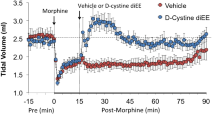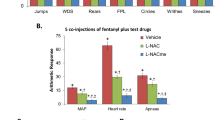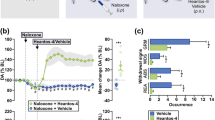Abstract
TOLERANCE and dependence are characteristic symptoms in man during prolonged use of opiates. We have pointed out1 that for an understanding of these phenomena the interaction between endogenous enkephalin and exogenous opiates is of importance. Normally, enkephalin can be assumed to control inhibitory mechanisms determining the rate of neurotransmitter release. If, however, opiates are administered with the intent of increasing the effects of these inhibitory mechanisms, then control will pass from the endogenous enkephalin to the exogenous opiates. Since tachyphylaxis is a pharmacological characteristic of opiates, a state of tolerance will arise in which increasing amounts of opiates will be required to maintain the desired effect. As an important step in the elucidation of the mechanism of action of enkephalin, it was necessary to establish whether cross tolerance between enkephalin and opiates is found in morphine-tolerant animals. This point was tested in two morphine-sensitive models, the myenteric plexus-longitudinal muscle preparation from the guinea pig ileum2,3 and the mouse vas deferens4. As natural enkephalin consists of about 75% methionine–enkephalin and 25% leucine–enkephalin5, the relative potencies of synthetic methionine–enkephalin and morphine were compared in preparations obtained from animals with different degrees of tolerance. Cross tolerance between morphine and methionine–enkephalin was shown to occur in the two preparations obtained from animals implanted with morphine pellets.
This is a preview of subscription content, access via your institution
Access options
Subscribe to this journal
Receive 51 print issues and online access
$199.00 per year
only $3.90 per issue
Buy this article
- Purchase on Springer Link
- Instant access to full article PDF
Prices may be subject to local taxes which are calculated during checkout
Similar content being viewed by others
References
Kosterlitz, H. W., and Hughes, J., Life Sci., 17, 91–96 (1975).
Cowie, A. L., Kosterlitz, H. W., and Watt, A. J., Nature, 220, 1040–1042 (1968).
Paton, W. D. M., and Zar, M. A., J. Physiol., Lond., 194, 13–33 (1968).
Hughes, J., Kosterlitz, H. W., and Leslie, F. M., Br. J. Pharmac., 53, 371–381 (1975).
Hughes, J., et al., Nature, 258, 577–579 (1975).
Klee, W. A., and Streaty, R. A., Nature, 248, 61–63 (1974).
Goldstein, A., and Schulz, R., Br. J. Pharmac., 48, 655–666 (1973).
Schulz, R., Cartwright, C., and Goldstein, A., Nature, 251, 329–331 (1974).
Kosterlitz, H. W., Lydon, R. J., and Watt, A. J., Br. J. Pharmac., 39, 398–413 (1970).
Kosterlitz, H. W., and Watt, A. J., Br. J. Pharmac. Chemother., 33, 266–276 (1968).
Collier, H. O. J., Francis, D. L., McDonald-Gibson, W. J., Roy, A. C., and Saeed, S. A., Life Sci., 17, 85–90 (1975).
Sharma, S. K., Klee, W. A., and Niremberg, M., Proc. natn. Acad. Sci. U.S.A., 72, 3092–3096 (1975).
Author information
Authors and Affiliations
Rights and permissions
About this article
Cite this article
WATERFIELD, A., HUGHES, J. & KOSTERLITZ, H. Cross tolerance between morphine and methionine-enkephalin. Nature 260, 624–625 (1976). https://doi.org/10.1038/260624a0
Received:
Accepted:
Issue Date:
DOI: https://doi.org/10.1038/260624a0
This article is cited by
-
Are astroglial cells involved in morphine tolerance?
Neurochemical Research (1988)
-
Similarities and differences between d-ALA2 MET5 enkephalin amide and morphine in the induction of tolerance to their effects on catalepsy and on dopamine metabolism in the rat brain
Naunyn-Schmiedeberg's Archives of Pharmacology (1982)
-
Behavioral effects of ACTH and MSH peptides
Journal of Endocrinological Investigation (1981)
-
d-ala2-methionine-enkephalinamide self-administration in the morphine-dependent rat
Psychopharmacology (1980)
Comments
By submitting a comment you agree to abide by our Terms and Community Guidelines. If you find something abusive or that does not comply with our terms or guidelines please flag it as inappropriate.



